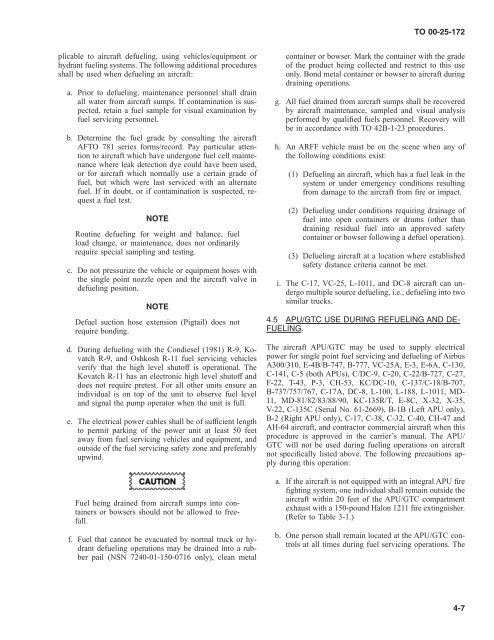TO 00-25-172 - Robins Air Force Base
TO 00-25-172 - Robins Air Force Base
TO 00-25-172 - Robins Air Force Base
Create successful ePaper yourself
Turn your PDF publications into a flip-book with our unique Google optimized e-Paper software.
<strong>TO</strong> <strong>00</strong>-<strong>25</strong>-<strong>172</strong><br />
plicable to aircraft defueling, using vehicles/equipment or<br />
hydrant fueling systems. The following additional procedures<br />
shall be used when defueling an aircraft:<br />
a. Prior to defueling, maintenance personnel shall drain<br />
all water from aircraft sumps. If contamination is suspected,<br />
retain a fuel sample for visual examination by<br />
fuel servicing personnel.<br />
b. Determine the fuel grade by consulting the aircraft<br />
AF<strong>TO</strong> 781 series forms/record. Pay particular attention<br />
to aircraft which have undergone fuel cell maintenance<br />
where leak detection dye could have been used,<br />
or for aircraft which normally use a certain grade of<br />
fuel, but which were last serviced with an alternate<br />
fuel. If in doubt, or if contamination is suspected, request<br />
a fuel test.<br />
NOTE<br />
Routine defueling for weight and balance, fuel<br />
load change, or maintenance, does not ordinarily<br />
require special sampling and testing.<br />
c. Do not pressurize the vehicle or equipment hoses with<br />
the single point nozzle open and the aircraft valve in<br />
defueling position.<br />
NOTE<br />
Defuel suction hose extension (Pigtail) does not<br />
require bonding.<br />
d. During defueling with the Condiesel (1981) R-9, Kovatch<br />
R-9, and Oshkosh R-11 fuel servicing vehicles<br />
verify that the high level shutoff is operational. The<br />
Kovatch R-11 has an electronic high level shutoff and<br />
does not require pretest. For all other units ensure an<br />
individual is on top of the unit to observe fuel level<br />
and signal the pump operator when the unit is full.<br />
e. The electrical power cables shall be of sufficient length<br />
to permit parking of the power unit at least 50 feet<br />
away from fuel servicing vehicles and equipment, and<br />
outside of the fuel servicing safety zone and preferably<br />
upwind.<br />
Fuel being drained from aircraft sumps into containers<br />
or bowsers should not be allowed to freefall.<br />
f. Fuel that cannot be evacuated by normal truck or hydrant<br />
defueling operations may be drained into a rubber<br />
pail (NSN 7240-01-150-0716 only), clean metal<br />
container or bowser. Mark the container with the grade<br />
of the product being collected and restrict to this use<br />
only. Bond metal container or bowser to aircraft during<br />
draining operations.<br />
g. All fuel drained from aircraft sumps shall be recovered<br />
by aircraft maintenance, sampled and visual analysis<br />
performed by qualified fuels personnel. Recovery will<br />
be in accordance with <strong>TO</strong> 42B-1-23 procedures.<br />
h. An ARFF vehicle must be on the scene when any of<br />
the following conditions exist:<br />
(1) Defueling an aircraft, which has a fuel leak in the<br />
system or under emergency conditions resulting<br />
from damage to the aircraft from fire or impact.<br />
(2) Defueling under conditions requiring drainage of<br />
fuel into open containers or drums (other than<br />
draining residual fuel into an approved safety<br />
container or bowser following a defuel operation).<br />
(3) Defueling aircraft at a location where established<br />
safety distance criteria cannot be met.<br />
i. The C-17, VC-<strong>25</strong>, L-1011, and DC-8 aircraft can undergo<br />
multiple source defueling, i.e., defueling into two<br />
similar trucks.<br />
4.5 APU/GTC USE DURING REFUELING AND DE-<br />
FUELING.<br />
The aircraft APU/GTC may be used to supply electrical<br />
power for single point fuel servicing and defueling of <strong>Air</strong>bus<br />
A3<strong>00</strong>/310, E-4B/B-747, B-777, VC-<strong>25</strong>A, E-3, E-6A, C-130,<br />
C-141, C-5 (both APUs), C/DC-9, C-20, C-22/B-727, C-27,<br />
F-22, T-43, P-3, CH-53, KC/DC-10, C-137/C-18/B-707,<br />
B-737/757/767, C-17A, DC-8, L-1<strong>00</strong>, L-188, L-1011, MD-<br />
11, MD-81/82/83/88/90, KC-135R/T, E-8C, X-32, X-35,<br />
V-22, C-135C (Serial No. 61-2669), B-1B (Left APU only),<br />
B-2 (Right APU only), C-17, C-38, C-32, C-40, CH-47 and<br />
AH-64 aircraft, and contractor commercial aircraft when this<br />
procedure is approved in the carrier’s manual. The APU/<br />
GTC will not be used during fueling operations on aircraft<br />
not specifically listed above. The following precautions apply<br />
during this operation:<br />
a. If the aircraft is not equipped with an integral APU fire<br />
fighting system, one individual shall remain outside the<br />
aircraft within 20 feet of the APU/GTC compartment<br />
exhaust with a 150-pound Halon 1211 fire extinguisher.<br />
(Refer to Table 3-1.)<br />
b. One person shall remain located at the APU/GTC controls<br />
at all times during fuel servicing operations. The<br />
4-7
















